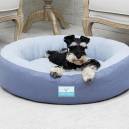How to acclimate your dog to a new home environment
September 01, 2011 • At Home • Health & Wellness •
Moving to a new home or apartment can be exciting, but very stressful, especially when it comes to acclimating your pet to their new environment. The good news is the process for acclimating a dog to a new home is very similar to doing so with a new puppy. The benefit is that the dog already knows the family, etc.
Below are just a few tips to help your pooch become more comfortable in his or her new surroundings that will help minimize the impact of your move.
- First, create a dog-proofed room or area in the house. If the dog is already crate trained, this is where his crate should be, along with some fun toys and chews. This is very important as this is where you will keep the dog (initially) when you cannot keep an eye on him. He should also be confined to this dog-safe area when you are out of the house.
- Take your dog outside often so he learns “where the bathroom is”. Dogs can be very particular about where they do their business, so be sure to give him a few extra bathroom trips each day as well as extra time during those trips. This will not only help him learn where “outside” is in this new environment, but will allow him time to sniff around to find his favorite spots.
- Keep the dog with you around the house. When the dog is out of his dog-proofed room, be sure to monitor him. Things are likely to seem very new to him. He will be curious and may engage in unwanted behaviors such as chewing, etc. Whatever room you are in, the dog should be in as well. When you are unable to physically manage the dog, he should be returned to his dog-proofed room/area with a nice stuffed Kong or other chew to keep him occupied.
- Pick feeding and sleeping areas and stick with them. Dogs are creatures of habit and routine. Creating familiarity with important resources such as food, water, and bedding is important.
- As the dog gets used to his surroundings you may begin easing his restrictions (i.e. expand his dog-proofed area gradually, reduce the number of trips outside to a more normal amount, leave him unsupervised for longer and longer periods, etc.)
- Most importantly, make your dog feel at home in his new surroundings. An abrupt change in living arrangements can be stressful for people and animals alike. Your dog depends on you to make this new home as friendly and safe as his old one.
Matthew Tuzzo, ABCDT, is president and head trainer of Jersey Shore Dogs, LLC, a positive, reward-based dog training company that specializes in in-home training and behavioral consulting. For more tips or additional information about dog training and behavior, email matt@jerseyshoredogtraining.com, visit www.jerseyshoredogtraining.com or www.facebook.com/JerseyShoreDogs.
Join the FIDO Friendly magazine pack and never a single issue of the one magazine your dog will thank you for.








